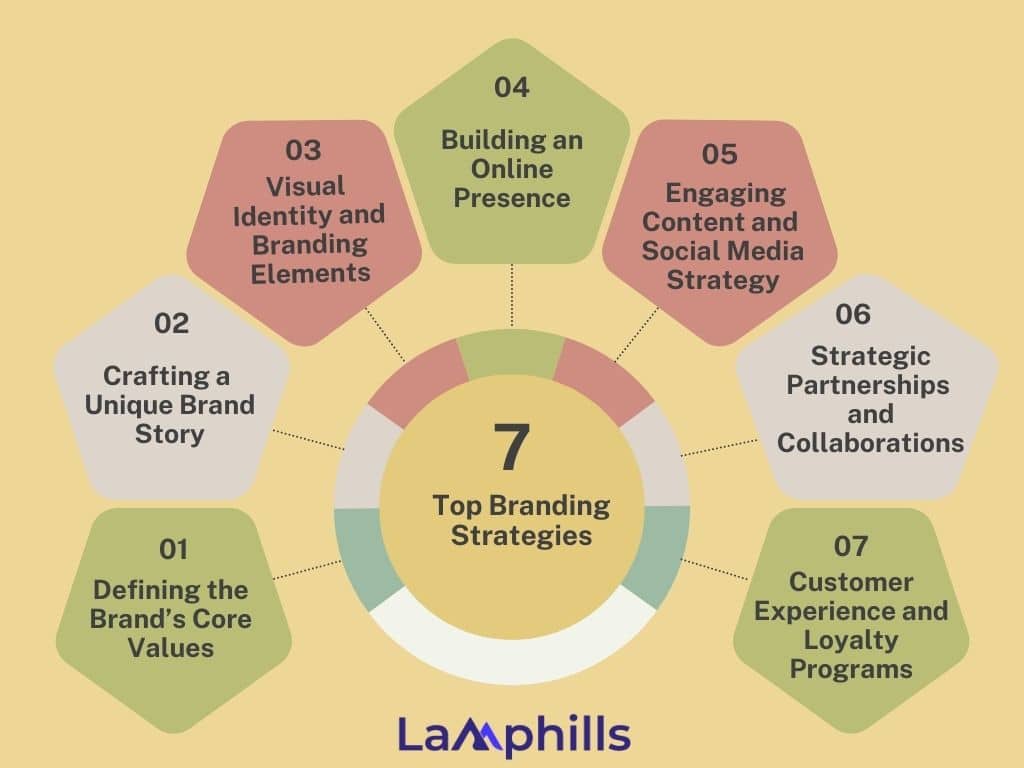If a company wants to stay relevant and profitable in business, there’s a need to stand tall amid competition. But how can a company ensure it connects with customers, draws attention, and builds relationships? The answer lies in branding. I’ve devoted time and resources to understanding branding and how it works. I’ve also crafted and refined strategies for various businesses as a marketer, and this is one thing I’ve learned: “Branding is not just about logos or catchy taglines—it’s the heart and soul of your business.” This guide delves into the core purpose of branding and explores the 10+ significant benefits it brings to your business.
Key Points
- Branding defines who you are, what you stand for, and how you want to be perceived in the market. It’s a business’ unique identity that resonates with your target audience.
- The primary purpose of branding is to differentiate your business from competitors, establish trust, and create a memorable experience for customers.
- The three Rs of branding Recognition, Reputation, and Relevance are foundational to building a strong, enduring brand.
- Investing in branding is not another marketing expense—it’s a strategic asset that drives long-term business success.
Understanding the Core Purpose of Branding
Branding is a business’ unique identity that resonates with your target audience. The primary purpose of branding is to differentiate you from competitors, establish trust, and create a memorable experience for customers. It defines who you are, what you stand for, and how you want to be perceived in the market.
In my experience, a strong brand does more than just attract customers; it creates an emotional connection that fosters loyalty and advocacy. Branding is the foundation upon which all your marketing efforts are built.
What Branding is About
Branding is a powerful tool that goes beyond creating a visual identity. It’s about building a connection with your audience, establishing trust, and creating a foundation for long-term success.
10+ Benefits of Branding for Your Business
The benefits I’ll outline below are not just theoretical—they’re based on real-world experiences and the tangible impact I’ve seen across industries.
#1. Leads to Brand Recognition
Generally, branding involves various creative activities geared towards increased recognition. A strong brand identity—think of the swoosh of Nike or the golden arches of McDonald’s—makes your business instantly recognizable. Moreover, consumers tend to choose brands they are familiar with over others. Over the years, I’ve learned that recognition builds familiarity, and familiarity breeds trust.
According to Nielsen, 59% of consumers prefer buying new products from familiar brands to those from unknown brands. In other words, familiarity can make customers choose one product over another.
#2. It Builds Customer Loyalty
Aside from recognition, one of the great benefits of branding is customer loyalty. Once customers can recognize your brand, there’s an emotional connection that comes with it. Branding is not just about attracting customers; it’s about keeping them. When a brand resonates with its audience on an emotional level, it fosters loyalty. I’ve seen how brands that stay true to their values or deliver on their promises create a loyal customer base.
These loyal customers are more than just repeat buyers—they become brand advocates. Bain & Company’s research shows that increasing customer retention rates by just 5% can increase profits by 25% to 95%, highlighting the financial impact of loyalty.
#3. Increased Business Value
One of the things I’ve observed in my career is how brands that invest in building a strong identity often see their market position and valuation soar. Little wonder why Interbrand’s 2023 report on the Best Global Brands, which collectively values the top 100 brands at over $3 trillion, underscores how branding directly influences a company’s worth. You simply can’t separate value from branding in business.
#4. Higher Perceived Value and Pricing Power
When your brand is identified with quality, innovation, or luxury, customers are willing to pay more, as seen with Apple products. Branding allows you to command premium prices. I’ve worked with brands that, through strategic branding, have been able to shift consumer perception and justify higher prices.
For instance, companies like Rolex or Tesla can charge a premium because their branding positions them as leaders in quality and innovation. A McKinsey study found that companies with strong brands enjoy a 20% higher return to shareholders than weaker brands.
#5. Enhanced Credibility and Trust
I’ve discovered that consistency in branding—whether in messaging, visuals, or customer experience—builds credibility over time. Brands that are reliable and transparent in their communications are more likely to gain consumer trust.
Trust is the cornerstone of any successful brand. Edelman’s 2023 Trust Barometer revealed that 61% of consumers trust the products and services of transparent brands. Trust also converts prospects into long-term customers.
#6. Improved Employee Satisfaction and Engagement
Branding doesn’t just impact customers; it profoundly influences employees as well. I’ve seen how a strong brand culture attracts and retains top talent. Employees who are proud to be associated with a brand are more engaged, motivated, and productive. A LinkedIn survey found that companies with strong employer brands see a 28% reduction in turnover rates and save 50% on hiring costs.
In my experience, this alignment between brand and employee satisfaction creates a positive feedback loop that benefits the entire organization.
#7. Better Market Positioning
Effective branding allows you to position your business strategically in the market. I’ve worked with companies that have used branding to carve out a unique niche, making their products or services the go-to choice in their industry. Take Tesla, for example—the brand’s focus on innovation and sustainability has positioned it as a leader in the electric vehicle market. Clear market positioning through branding is essential for standing out in a crowded marketplace.
#8. Easier Introduction of New Products
Launching new products is significantly easier when you have a strong brand. I’ve witnessed this countless times: it’s easier for customers to try new products or services from popular brands than unknown ones. For example, every time Apple releases a new product, there’s instant consumer interest and trust, largely due to the brand’s established, reputation. A Nielsen study supports this, showing that 63% of consumers are more likely to purchase a new product from a brand they already know.
#9. Effective Marketing and Communication
A strong brand serves as the foundation for all marketing efforts. When your branding is solid, every marketing campaign becomes more effective because it resonates deeply with your audience. I’ve seen how consistent branding across all channels—social media, advertising, and content marketing—can reinforce your message and make it more memorable. Lucidpress reports that consistent brand presentation across platforms can increase revenue by up to 23%.
#10. Competitive Advantage
Branding is your secret weapon in the battle against competitors. I’ve seen brands with strong identities dominate their markets, even in highly competitive industries. A strong brand can make your business the preferred choice, leading to increased market share. According to BrandZ, brands perceived as “different” and “meaningful” grow 4.5 times faster than those that aren’t. This differentiation is key to standing out and staying ahead of the competition.
#11. Attracting Talent
A strong brand doesn’t just attract customers—it attracts talent. I’ve noticed that employees are drawn to trusted brands not just consumers. Companies like Google and Microsoft are prime examples; their strong brand identities make them magnets for top talent. A study by Glassdoor shows that 69% of job seekers are more likely to apply for a job if the company actively manages its brand. In my experience, having a strong brand can make all the difference in attracting the best people to your team.
#12. Long-Term Business Stability
Finally, strong branding contributes to long-term stability. Over time, I’ve seen how brands with solid equity can weather market fluctuations and economic downturns more effectively than those without. Generally, branding helps build loyal customers who stick around even during tough times. This will eventually result in a stable revenue base. McKinsey highlights that companies with strong brands consistently outperform the market, even during economic downturns. This stability is invaluable for any business looking to achieve sustainable growth.
Purpose of Branding: A Journey of Transformation
One of the most rewarding experiences in my career as a branding expert was helping a small, family-owned business transform into a recognized and respected brand in its industry. The business, a local organic skincare company, had been struggling to stand out in a saturated market. Despite offering high-quality products, sales and customer loyalty were low. They approached me with a simple yet profound question: “How can we make our brand memorable?”
Purpose of Branding: The Challenge
The business had been operating for a few years but was virtually unknown outside their small community. They have amazing products but lack a cohesive brand identity that could communicate their values and differentiate them from competitors. The challenge was clear: we needed to create a brand that resonated with their target audience and positioned them as a leader in the organic skincare industry.
Top Branding Strategies

Below are my top branding strategies that were used to address the issue mentioned above:
#1. Defining the Brand’s Core Values
The first step was to delve deep into the essence of the business. I spent time with the owners to understand their vision, mission, and values. What became evident was their unwavering commitment to sustainability, natural ingredients, and ethical practices. These values were the foundation upon which we would build the brand.
#2. Crafting a Unique Brand Story
Every successful brand has a compelling story, theirs was no exception. We crafted a narrative with the founders’ passion for organic skincare, their journey in sourcing the purest ingredients, and their dedication to environmental sustainability. This story became the cornerstone of all branding efforts, providing a human touch that resonated with customers.
#3. Visual Identity and Branding Elements
Next, we created a visual identity that aligned with the brand’s values. This included designing a logo that reflected the natural and organic essence of the products, choosing a color palette inspired by nature, and selecting typography that conveyed simplicity and elegance. Every element was meticulously chosen to ensure consistency across all touchpoints.
#4. Building an Online Presence
A strong online presence is necessary for brand success. As a result, we revamped the company’s website, focusing on user experience and storytelling. The website became a platform to showcase the products and the brand’s commitment to sustainability. We also optimized the site for search engines, to ensure that customers could easily find them.
#5. Engaging Content and Social Media Strategy
To build awareness and engage with the target audience, we developed a content strategy that included blog posts, social media campaigns, and email newsletters. The content was educational, focusing on the benefits of organic skincare and the importance of sustainable living. We also leveraged social media platforms to connect with customers, share the brand’s story, and promote products.
#6. Strategic Partnerships and Collaborations
To enhance credibility and reach a wider audience, we identified strategic partnerships with influencers and other brands that shared similar values. Collaborations with eco-friendly bloggers and participation in sustainability events helped position the brand as an authority in the organic skincare space.
#7. Customer Experience and Loyalty Programs
Finally, we focused on creating an exceptional customer experience. From packaging to post-purchase follow-ups, every interaction with the brand was designed to delight customers. We also introduced a loyalty program that rewarded repeat customers, fostering long-term relationships and encouraging word-of-mouth referrals.
Back to our Story: The Results
The transformation was remarkable. Within a year, the business saw a significant increase in brand recognition, customer loyalty, and sales. Their social media following grew exponentially, and they started receiving inquiries from retailers interested in carrying their products. The brand became synonymous with quality, sustainability, and trust in the organic skincare market.
What Are the Three Main Purposes of Branding?
The three main purposes of branding are to differentiate your business, build trust and credibility, and establish an emotional connection with your audience. These elements work together to create a strong brand that attracts and retains customers.
Lamphills’ Branding Checklist
Want to create a compelling brand? Use the checklist below to strategically brand your product or services.
Download Lamphills’ Branding Checklist
What is the Core Purpose of Branding?
The core purpose of branding is to create a distinct business identity that resonates with the target audience, fosters trust, and drives customer loyalty.
What Are the 3 Cs of Branding?
The three Cs of branding are Clarity, Consistency, and Connection. These three keywords help businesses build and maintain resonance with their target audience.
What are the 3 Rs of Branding
The three Rs of branding are Recognition, Reputation, and Relevance. These are foundational to building a strong, enduring brand.
Conclusion
I’d love to buttress a few things to drive my points home on the purpose of branding. First, investing in branding is not another marketing expense—it’s a strategic asset that drives long-term business success. Secondly, the benefits of strong branding practices are undeniable. Aside from increasing brand recognition, it builds customer loyalty and can significantly boost a company’s value and competitive edge if done correctly and strategically.
As someone who has helped businesses large and small build and refine their brands, I can attest to the transformative power of branding. If you haven’t already, now is the time to invest in your brand and reap the benefits it brings.
Related Articles
- Small Business Branding Ideas: 15 Creative Ideas for 2024
- The Importance of Branding in Financial Services (+ Examples)
- Global Branding Strategies: Key Principles for International Success
- 41 Rebranding Announcement Examples That Inspire Me Every Time
- Mastering B2B Online Marketing: Strategies, Trends, and Insights






